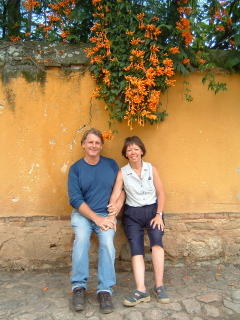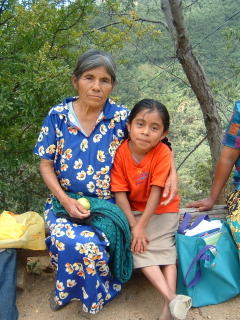Thursday, September 22, 2005
Tuesday, September 20, 2005
Encounters with Grace in the Margins

All together now, keep your eyes open beyond yourselves, see the margins of the world, where those who are different from us are waiting to demonstrate that they are as human as we. Reconize yourselves in he or she who are not like you or me.
Carlos Fuentes
I think living with this gecko, this cuija (Kwee-hah) will be good for me. I have never lived like this before. This gecko lives on the edge of the walls and ceilings near the window, free to scurry about when it comes out at night.
As a kid, these creatures were usually behind glass or maybe wire...separate and removed, fed and viewed occasionally in a cage of some kind. Now I am living with this gecko...or does it live with me? Not sure, but maybe this question will be good for me.
Local people here say, " Que bueno, tu tienes un cuija. Un invitado honorable! " ( How nice, you have a gecko. An honored guest. ) They say it is actually quite nice having them roam around; no problem, they eat mosquitos and gnats. People call them BESUCONA , the " kissing one " because they make a cute, homey and soft kissing sound. I will have to get used to that.
These geckos have really incredible suction-padded toes. They can cling to completely smooth and vertical surfaces. They have often chosen to adapt to our intrusion and somehow make do with this in their niches, whenever they can find them.
So, I guess I can meet then halfway...perhaps I can learn how to adapt a bit more. Maybe I don't need to feel so spooked because I am not used to this living arrangement. I am kind of glad, I guess, that I didn't whack him with a broom right away. He seems to be doing the necessary tough job of getting rid of pests. It could be we are actually helping one another live better.
This gecko runs away sometimes when I enter the room, nervous I guess, probably lots of his buddies have been whacked before. But I think we are slowly beginning to realize that this can work. I'll have to learn this better, not to whack at things I don't understand. It takes awhile for sure...we're different, but I think it will be good for us.
The End
Tuesday, September 06, 2005
Journey to the Mixteca


The women gestured with hands to the face covering parts of the mouth, shielding the eyes, nervous smiles mixed with pride and humility, shy eyes with darting glances down and away.
These generations of rural and isolated Mixtec women are learning their first letters and sounds in Spanish. I doubt any coffee-table book of Mexico or souvenir of pottery, wool or tinware will match the simple beauty and lasting impression of us being a part of helping these indigenous people to smile when reconizing the letters of their own names...for the first time, ever.
The Mixtecs, or in their ancient language...Nyu-u Sabi..." People of the Rain or Clouds"..are a native people of upwards of 350,000 which make up about 30% of Oaxacan native speakers. The Mixtecs have existed as a group with a clear identity for at least 2,500 years with important civilizations in the central highlands and western coasts of Mexico.
These people were famous for their high degree of inventivness in arts and crafts, jewelry, pottery, sculpture, and for an unusually refined and successful diplomacy which they used with large influence in the area with a minimum of warfare. Also reconized for their agricultural ingenuity in very tough mountain conditions. But they are now one of the poorest in Oaxaca, or Mexico.
But they are one of the few indigenous American peoples to preserve their language, much of the culture, and a degree of control over the land in the face of five hundred years of colonial conquest and domination.
And so, Katy and I have begun to explore the option of volunteering many of our Saturdays with a group called Manos de Vida, which assists in many community projects among the poorer, marginalized groups of Oaxaca city and the regional pueblos. Our most recent outing, three hours on dirt roads high up (10,000 ft.) into the mountainous Mixteca region due west of Oaxaca city, was with a pueblo literacy project in partnership with a Mexican national rural literacy project.
Perhaps 90% of children up to 15 yrs. now speak Spanish due to the effective outreaches of rural schools. But only 20% of adults can speak and read Spanish. Linguists reconize 16 separate native languages in Oaxaca, and so in the larger market towns Spanish is the language for commerce.
We are humbled and impressed by these people. We admire this project and hope to offer our time. We have simple gifts to give, but we can speak some Spanish enough to teach the sounds of letters and the beginning sounds of personal names of a proud and beautiful people.
Simple gifts, actually, can be quite the hard ones at times. Your thoughts and prayers for us can help us deliver the hard and simple...into the the received soft and profound.
Que milagro! Dios le bendiga, paz en su vida






